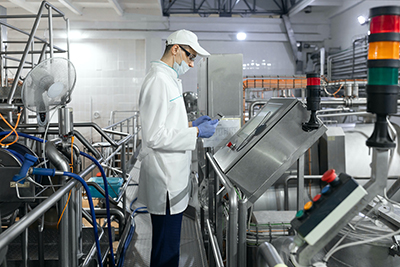Sustainability, without question, is one of the hottest social and political topics today. It is as complex as it is simple. Sustainability gets discussed in almost every walk of life, but in the world of food manufacturing, there are few subjects more debated than this one. It is a contentious subject because in the manufacturing arena, it is not just a social or political issue, it is a financial issue—a big financial issue. Sustainability and related issues around it are critical factors and components that are now impacting the bottom lines of food manufacturers. The impact is seen in terms of both red and black.
In a low-margin business like food manufacturing, profits are at a premium and even a minor disruption can negatively impact those profits. Adapting to all the issues that are involved in and around sustainability is, without question, a disruption for manufacturers. At the same time, manufacturers can make positive impacts through smart operational decision-making, which is where sustainability has the greatest presence. When sustainability is discussed in regards to food and beverage manufacturing, a number of topics surface. Some topics are discussed individually and some are grouped together. Consumer preferences, new foods, and packaging are three such areas. At first glance, you might ask why they are lumped together. They are lumped together because they are actually very closely related. Let’s explore those connections especially as they relate to finances.
Consumer Preferences: Paving the Sustainable Path
Consumer preferences have always been one of the leading factors determining what food and beverage manufacturers produce and send to market. For generations, countless amounts of time and money have been spent on trying to predict what consumers want and when they want it. A tremendous amount of data is painstakingly analyzed by manufacturers trying to figure out the consumer’s next move.
According to a 2018 Global Web Index survey, half of digital consumers say environmental concerns influence their purchasing decisions. Millennials—sometimes named the Green Generation—and Generation Z lead the way. About 61% of millennials and 58% of Gen Z’ers say they would pay more for eco-friendly products. Green consumers want brands to embrace purpose and sustainability, and they want their purchases to contribute to the greater good, or at least, do no harm.
These preferences started among millennials and Gen Z’ers, but with the influence of social media, they have expanded to all age groups. This expansion has contributed greatly to a change in what consumers purchase and to what manufacturers produce. In recent years, consumers have changed their eating habits in terms of what they eat, how they eat and when they eat, and those changes have impacted both food service and retail food producers. They have largely centered on healthier foods, pure ingredients and products that promote an eco-friendly culture and a sustainable world. The changes have been felt up and down manufacturing organizations, but most importantly they are reflected in the bottom line.
The industry has been forced to introduce healthier products, with more ethically sourced ingredients and more transparent supply chains. Younger consumers, especially, often trace a brand’s sustainability record with QR codes or smart labels. They want to know where their food originates. They don’t just want to know in which state the potato used in their organic baked potato crisp was grown. They want to know the county, town, farm, field and names of the people who picked it so they can connect with them on Facebook to determine if they practice safe hygiene principles! If a product doesn’t fit the consumers’ predetermined sustainable criteria, they buy a product from another manufacturer. Talk about an impact to profits. The consumer focus on sustainability has increased competition and costs, forced organizational changes and made food manufacturers figure out what processes and systems need to be in place to ensure their decisions keep consumers happy and their profits on the right side of the ledger. These consumer actions and attitudes are now influencing the development of new food items as manufacturers realize consumers are not just taking notice but taking actions as well.
New Foods: Where’s the Beef? Not Here!
As consumers change their food preferences for health and sustainability reasons, food and beverage producers have the opportunity, responsibility and if they want to survive, the mandate to develop new food products built on a reputation for sustainability. Brands have been working on protein alternatives for some time, but not until Burger King and McDonald’s introduced plant-based burgers did plant-based protein go “viral” so to speak. Talk about “Where’s the beef?” In addition to meeting the needs of the drive for sustainable foods, food manufacturers are developing plant-based proteins and many new foods to support the healthier lifestyle movement. As consumers embrace Keto diets, veganism, vegetarianism and other new eating and living practices, tofu, soybeans, seeds, nuts, legumes and other vegetable-based products are now being routinely used as replacements for protein, carbohydrate-heavy flours and food foundation bases.
Ten years ago, if I said in 2021 we would be eating pizza with a crust made of cauliflower, what would the public reaction have been? People in Chicago would have thrown away their deep-dish pans. Food manufacturers now introduce new products on a weekly basis and it is having a tremendous impact on sales and bottom lines. These rapid introductions also impact other key areas of the organization including supply chain, product development cycle and manufacturing cost infrastructure.
Substituting vegetables for carbohydrate-rich grains, of course, costs money. It can increase material costs, manufacturing costs, warehousing costs and distribution costs, which combine to raise retail prices. Luckily, as we have illustrated, consumers are willing to pay more for products that they perceive as having a sustainable footprint. Utilizing products differently to respond to the push for sustainability is a smart tactic that can expand the value chain, open up new markets and drive sales for food and beverage manufacturers.
Packaging Sells Products and Sustainability
Sustainable packaging can mean many things. It can mean packaging made with 100% recycled or raw materials, packaging with a minimized carbon footprint due to a streamlined production process or supply chain, or packaging that is recycled or reused. There is also biodegradable packaging like containers made from cornstarch being used for takeout meals.
For generations, packaging has had a tremendous influence on what consumers buy. Human beings are visual creatures. They are drawn to things that have visual and physical characteristics that appeal to the senses. How many products in the marketplace are known for a certain shape or color configuration? Many times, these shapes or colors can only be created using certain glass, plastic or other materials that might not meet the sustainable criteria. This has caused problems for manufacturers as consumers still want those products but are conflicted if their sustainable beliefs are compromised. Adapting new eco-friendly materials while retaining generations of packaging history and nostalgia can increase costs. But, to keep their customers, manufacturers make these changes, absorb the extra costs and try to make up for lost profits in other ways.
Packaging, especially smart packaging, can also help fight the battle against food waste. Packaging companies are creating and producing intelligent packaging for food products that have built-in sensors and monitors to determine when a product will lose its nutritional value or spoil. Smart labels are being used in conjunction with new packaging materials to monitor external factors that can influence product freshness. Packaging can be a driving force to reaching the goal of sustainability.
Adapting to changing consumer preferences, demand for new foods and new packaging materials and designs is critical for manufacturers trying to reach sustainable goals. Consumer preferences drive what manufacturers produce. Consumer preferences drive the development of new foods that consumers think they need in order to live a healthier lifestyle. Packaging is the wrapper that keeps the new foods fresh and catches the consumer’s eye, which in turn drives sales and thus drives profits. These three critical areas can be the foundation of the sustainable movement and manufacturing’s response to it. Food producers must embrace the sustainable movement if they want to stay in business. To meet this challenge, manufacturers of packaging and food need to evaluate their processes and systems and implement the ones that can help them cost-effectively transition to becoming sustainable manufacturers.






















